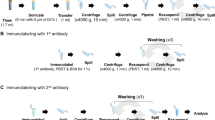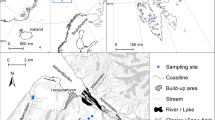Abstract
Red tides of Heterocapsa circularisquama have led to serious damage of bivalve aquacultures in western coastal areas of Japan. To understand the whole picture regarding the ecology of this species, it is essential to clarify its overwintering mechanisms. In this study, the population dynamics of H. circularisquama were investigated from February 2004 to November 2005, and overwintering cells were identified for the first time in water columns of Uranouchi Inlet, Kochi Prefecture, Japan. Heterocapsa circularisquama cells were detected by the indirect fluorescent antibody technique using monoclonal antibodies that specifically recognize and react to this species. Vegetative cells were almost always detected from the first observation in February 2004 to November 2005 with temperatures of 10.5–30.6°C. During the period from winter to spring, this species survived in areas with a temperature higher than 10°C. The overwintering cells of H. circularisquama were isolated in March 2004, and identification was made via observation of the morphology and body scales of the cultured cells. These overwintering cells were identified as H. circularisquama and reacted to the monoclonal antibody. These results indicate that H. circularisquama can overwinter and survive throughout the year in a vegetative cell state in Uranouchi Inlet.
Similar content being viewed by others
References
Matsuyama Y, Usuki H, Uchida T, Kotani Y. Effects of harmful algae on the early planktonic larvae of the oyster, Crassostrea gigas. In: Hallegraeff GA, Blackburn SI, Bolch CJ, Lewis RJ (eds). Harmful Algal Blooms 2000. IOC-UNESCO, Paris. 2001; 411–414.
Imai I, Yamaguchi M, Hori Y. Eutrophication and occurrences of harmful algal blooms in the Seto Inland Sea, Japan. Plankton Benthos Res. 2006; 1: 71–84.
Tamai K. Current status of outbreaks and fisheries damages due to Heterocapsa circularisquama. Bull. Plankton Soc. Jpn. 1999; 46: 153–154 (in Japanese).
Matsuyama Y, Uchida T, Honjo T, Shumway SE. Impacts of the harmful dinoflagellate, Heterocapsa circularisquama, on shellfish aquaculture in Japan. J. Shellfish Res. 2001; 20: 1269–1272.
Matsuyama Y. Physiological and ecological studies on harmful dinoflagellate Heterocapsa circularisquama — I Elucidation of environmental factors underlying the occurrence and development of H. circularisquama red tide. Bull. Fish. Res. Agency 2003; 7: 24–105.
Nakanishi K, Onaka S, Kobayashi T, Masuda K. Bloom dynamics of Heterocapsa circularisquama in Ago Bay, Japan. Bull. Plankton Soc. Jpn. 1999; 46: 161–164 (in Japanese).
Shiraishi T, Hiroishi S, Nagai K, Go J, Yamamoto T, Imai I. Seasonal distribution of the shellfish killing dinoflagellate Heterocapsa circularisquama in Ago Bay monitored by indirect fluorescent antibody technique using monoclonal antibodies. Plankton Benthos Res. 2007; 2: 49–62.
Hiroishi S, Nakai R, Seto H, Yoshida T, Imai I. Identification of Heterocapsa circularisquama by means of antibody. Fish. Sci. 2002; 68 (Suppl. I): 627–628.
Yamaguchi M, Itakura S, Nagasaki K, Matsuyama Y, Uchida T, Imai I. Effects of temperature and salinity on the growth of the red tide flagellates Heterocapsa circularisquama (Dinophyceae) and Chattonella verruculosa (Raphidophyceae). J. Plankton Res. 1997; 19: 1167–1174.
Yamatogi T, Sakaguchi M, Matsuda M, Iwanaga S, Iwataki M, Matsuoka K. Effect on bivalve molluscs of a harmful dinoflagellate Heterocapsa circularisquama isolated from Omura Bay, Japan and its growth characteristics. Nippon Suisan Gakkaishi 2005; 71: 746–754.
Horiguchi T. Heterocapsa circularisquama sp. nov. (Peridiniales, Dinophyceae): a new marine dinoflagellate causing mass mortality of bivalves in Japan. Phycol. Res. 1995; 43: 129–136.
Iwataki M, Hansen G, Sawaguchi T, Hiroishi S, Fukuyo Y. Investigations of body scales in twelve Heterocapsa species (Peridiniales, Dinophyceae), including a new species H. pseudotriquetra sp. nov. Phycologia 2004; 43: 394–403.
Chen LCM, Edelstein T, McLachlan J. Bonnemaisonia hamifera Hariot in nature and in culture. J. Phycol. 1969; 5: 211–220.
Imai I, Itakura S, Matsuyama Y, Yamaguchi M. Selenium requirement for growth of a novel red tide flagellate Chattonella verruculosa (Raphidophyceae) in culture. Fish. Sci. 1996; 62: 834–835.
Yoshida T, Sako Y, Uchida A. Geographic differences in paralytic shellfish poisoning toxin profiles among Japanese populations of Alexandrium tamarense and A. catenella (Dinophyceae). Phycol. Res. 2001; 49: 13–21.
Yoshimatsu S. The cysts of Fibrocapsa japonica (Raphidophyceae) found in bottom sediment in Harima-Nada, eastern Inland Sea of Japan. Bull. Plankton Soc. Jpn. 1987; 34: 25–31.
Imai I, Itoh K. Annual life cycle of Chattonella spp., causative flagellates of noxious red tides in the Inland Sea of Japan. Mar. Biol. 1987; 94: 287–292.
Imai I, Itoh K. Cysts of Chattonella antiqua and C. marina (Raphidophyceae) in sediments of the Inland Sea of Japan. Bull. Plankton Soc. Jpn. 1988; 35: 35–44.
Imai I. Cyst formation of the noxious red tide flagellate Chattonella marina (Raphidophyceae) in culture. Mar. Biol. 1989; 103: 235–239.
Imai I, Itakura S, Itoh K. Cysts of the red tide flagellate Heterosigma akashiwo, Raphidophyceae, found in bottom sediments of northern Hiroshima Bay, Japan. Nippon Suisan Gakkaishi 1993; 59: 1169–1173.
Nakata K, Iizuka S. A note on overwintering of a red tide dinoflagellate Gymnodinium nagasakiense (Dinophyceae) in Omura Bay, Kyusyu. Bull. Plankton Soc. Jpn. 1987; 34: 199–201.
Terada K, Ikeuchi H, Takayama H. Winter distribution of Gymnodinium nagasakiense (Dinophyceae) in coastal waters of Suo-Nada, Inland Sea of Japan. Bull. Plankton Soc. Jpn. 1987; 34: 201–204.
Honjo T, Yamamoto S, Nakamura O, Yamaguchi M. Annual cycle of motile cells of Gymnodinium nagasakiense and ecological features during the period of red tide development. In: Granéli E, Sundström B, Elder L, Anderson DM (eds). Toxic Marine Phytoplankton. Elsevier, New York. 1990; 165–170.
Itakura S, Imai I, Itoh K. Seasonal occurrence of the noxious red tide dinoflagellate Gymnodinium nagasakiense in Hiroshima Bay, Seto Inland Sea. Bull. Nansei Natl Fish. Res. Inst. 1990; 23: 27–33.
Honjo T, Imada N, Ohshima Y, Maema Y, Nagai K, Matsuyama Y, Uchida T. Potential transfer of Heterocapsa circularisquama with pearl oyster consignments. In: Reguera B, Blanco J, Fernandez ML, Wyatt T (eds) Harmful Algae. Xunta de Galicia and IOC of UNESCO, Vigo. 1998; 224–226.
Honjo T, Imada N. Future attention—Spread of Heterocapsa circularisquama red tides and its preventive measure. Bull. Plankton Soc. Jpn. 1999; 46: 180–181 (in Japanese).
Imada N, Honjo T, Shibata H, Oshima Y, Nagai K, Matsuyama Y, Uchida T. The quantities of Heterocapsa circularisquama cells transferred with shellfish consignments and the possibility of its establishment in new areas. In: Hallegraeff GM, Blackburn SI, Bolch CJ, Lewis RJ (eds). Harmful Algal Blooms 2000. IOC-UNESCO, Paris. 2001; 474–476.
Author information
Authors and Affiliations
Corresponding author
Rights and permissions
About this article
Cite this article
Shiraishi, T., Hiroishi, S., Taino, S. et al. Identification of overwintering vegetative cells of the bivalve-killing dinoflagellate Heterocapsa circularisquama in Uranouchi Inlet, Kochi Prefecture, Japan. Fish Sci 74, 128–136 (2008). https://doi.org/10.1111/j.1444-2906.2007.01502.x
Received:
Accepted:
Issue Date:
DOI: https://doi.org/10.1111/j.1444-2906.2007.01502.x




